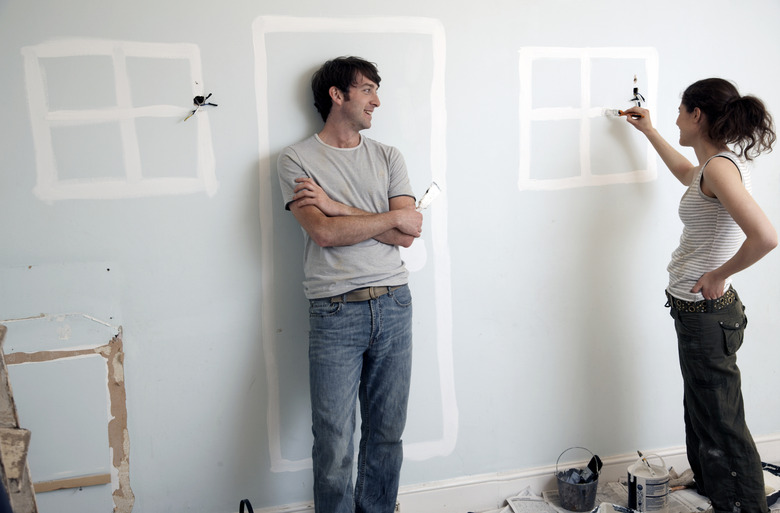How To Cover Up A Window To Look Like Part Of The Wall
Things Needed
-
Utility knife
-
Pry bar
-
Hammer
-
Sandpaper
-
Tape measure
-
1-by-1 inch boards
-
Chop saw, miter saw or hand saw
-
Plywood
-
Table saw, jig saw or circular saw
-
Drywall
-
Wood screws
-
Fiberglass insulation
-
Scissors
-
Sheetrock screws
-
Joint compound
-
Putty knife
-
Drywall tape
-
Primer
-
Paint
Temporary methods of covering a window, such as tacking up cardboard or a blanket, are often unsightly. Whether you need to create privacy, conceal damage, block light or add wall space, it is possible to permanently cover a window in a way that no one will know that a window was ever there. Cover your window using methods adopted from drywall installation.
Step 1
Score along the seams where the trim and sill meet the wall using a utility knife to sever any caulk or paint. Remove the trim and sill using a pry bar. Hit the bottom of the sill with a hammer to help release it from the wall.
Step 2
Sand away any imperfections left on the wall from removing the trim and sill using sandpaper.
Step 3
Measure the dimensions of the window cavity.
Step 4
Create a framework of 1-by-1-inch boards to fit around the inside of the window cavity. Use a chop saw, miter saw or hand saw to cut the wood.
Step 5
Cut a section of plywood to match the dimensions of the window cavity. Use a table saw, jig saw or a circular saw to cut the plywood.
Step 6
Cut a section of drywall using a utility knife to match the dimensions of the window cavity.
Step 7
Add the width of the plywood and drywall. Use this measurement to determine the depth at which to attach the 1-by-1 framework to the inside perimeter of the window. Secure the framework with wood screws.
Step 8
Cut a piece of fiberglass insulation to fill the cavity. Fiberglass insulation is soft and is cut with scissors. Stuff the insulation into the cavity, behind the added 1-by-1 framework.
Step 9
Fit the plywood into the cavity, against the framework. Screw the plywood to the framework boards.
Step 10
Fit the drywall into the cavity, against the plywood – so it lies flush with the surface of the surrounding wall. Screw the drywall to the plywood with drywall screws.
Step 11
Run a layer of joint compound over the crack between the new drywall and the old wall using a putty knife. To apply, pick up a gob of joint compound on the end of the putty knife and pull it along the seam holding the knife at a sharp angle. Use medium-firm pressure to force the compound into the crack.
Step 12
Run drywall tape over the crack, on top of the wet compound. Smooth down the tape by going over it with the putty knife.
Step 13
Apply another thin coat of joint compound to seal and cover the tape.
Step 14
Allow the joint compound to dry then sand it with sand paper to eliminate all imperfections.
Step 15
Apply joint compound to the area as needed to match the texture of the existing wall. It may be splattered, trowel-distressed or mixed with wall texture grit. Allow the texture to dry.
Step 16
Prime and paint the wall using the same primer and paint used on the surrounding wall.
